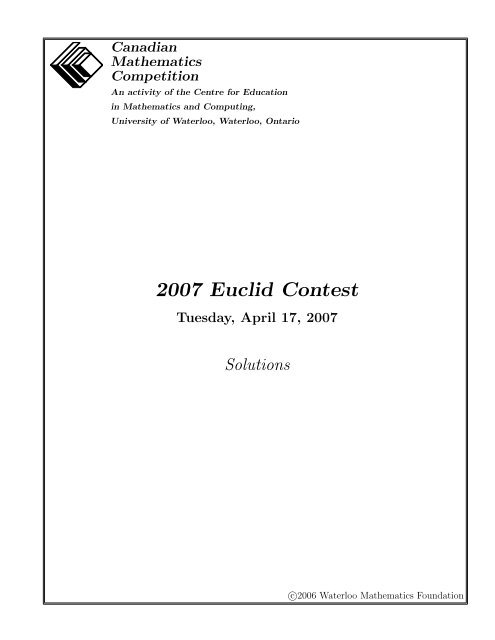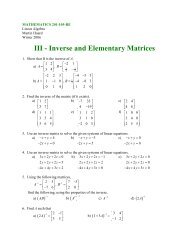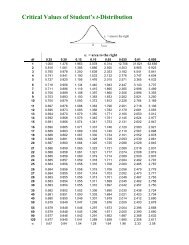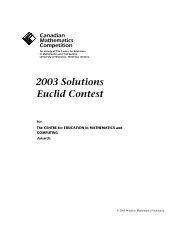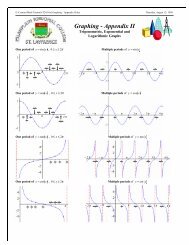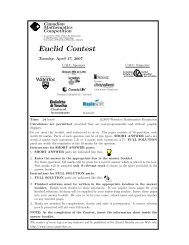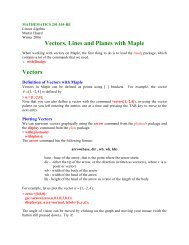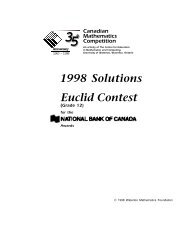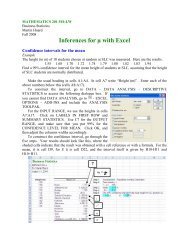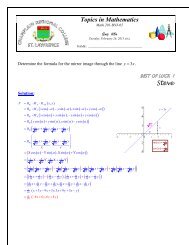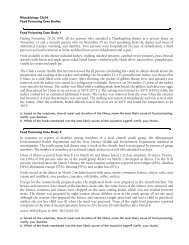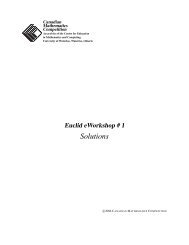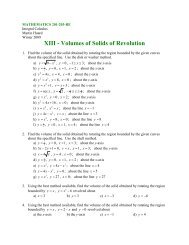Euclid Contest Solutions 2007 - CEMC - University of Waterloo
Euclid Contest Solutions 2007 - CEMC - University of Waterloo
Euclid Contest Solutions 2007 - CEMC - University of Waterloo
- No tags were found...
You also want an ePaper? Increase the reach of your titles
YUMPU automatically turns print PDFs into web optimized ePapers that Google loves.
<strong>2007</strong> <strong>Euclid</strong> <strong>Contest</strong> <strong>Solutions</strong> Page 21. (a) Since (a − 1, a + 1) lies on the line y = 2x − 3, then a + 1 = 2(a − 1) − 3 or a + 1 = 2a − 5or a = 6.(b) Solution 1To get from P to Q, we move 3 units right and 4 units up.Since P Q = QR and R lies on the line through Q, then we must use the same motion toget from Q to R.Therefore, to get from Q(0, 4) to R, we move 3 units right and 4 units up, so the coordinates<strong>of</strong> R are (3, 8).Solution 2The line through P (−3, 0) and Q(0, 4) has slopeequation y = 4 3 x + 4.Thus, R has coordinates (a, 4 a + 4) for some a > 0.3Since P Q = QR, then P Q 2 = QR 2 , soso a = 3 since a > 0.4 − 00 − (−3) = 4 3(−3) 2 + 4 2 = a 2 + ( 43 a + 4 − 4) 225 = a 2 + 16 9 a2259 a2 = 25a 2 = 9Thus, R has coordinates (3, 4 (3) + 4) = (3, 8).3(c) Since OP = 9, then the coordinates <strong>of</strong> P are (9, 0).Since OP = 9 and OA = 15, then by the Pythagorean Theorem,so AP = 12.AP 2 = OA 2 − OP 2 = 15 2 − 9 2 = 144and y-intercept 4, so hasSince P has coordinates (9, 0) and A is 12 units directly above P , then A has coordinates(9, 12).Since P B = 4, then B has coordinates (13, 0).The line through A(9, 12) and B(13, 0) has slope 12 − 09 − 13form, has equation y − 0 = −3(x − 13) or y = −3x + 39.= −3 so, using the point-slope2. (a) Since cos(∠BAC) = AB5and cos(∠BAC) =13AC and AB = 10, then AC = 13 AB = 26.5Since △ABC is right-angled at B, then by the Pythagorean Theorem,BC 2 = AC 2 − AB 2 = 26 2 − 10 2 = 576 so BC = 24 since BC > 0.Therefore, tan(∠ACB) = ABBC = 1024 = 5 12 .
<strong>2007</strong> <strong>Euclid</strong> <strong>Contest</strong> <strong>Solutions</strong> Page 44. (a) Solution 1Rearranging and then squaring both sides,so x = 3 or x = 6.2 + √ x − 2 = x − 2√x − 2 = x − 4x − 2 = (x − 4) 2x − 2 = x 2 − 8x + 160 = x 2 − 9x + 180 = (x − 3)(x − 6)We should check both solutions, because we may have introduced extraneous solutions bysquaring.If x = 3, the left side equals 2 + √ 1 = 3 and the right side equals 1, so x = 3 must berejected.If x = 6, the left side equals 2 + √ 4 = 4 and the right side equals 4, so x = 6 is the onlysolution.Solution 2Suppose u = √ x − 2.The equation becomes 2 + u = u 2 or u 2 − u − 2 = 0 or (u − 2)(u + 1) = 0.Therefore, u = 2 or u = −1.But we cannot have √ x − 2 = −1 (as square roots are always non-negative).Therefore, √ x − 2 = 2 or x − 2 = 4 or x = 6.We can check as in Solution 1 that x = 6 is indeed a solution.(b) Solution 1From the diagram, the parabola has x-intercepts x = 3 and x = −3.Therefore, the equation <strong>of</strong> the parabola is <strong>of</strong> the form y = a(x − 3)(x + 3) for some realnumber a.Triangle ABC can be considered as having base AB (<strong>of</strong> length 3 − (−3) = 6) and heightOC (where O is the origin).Suppose C has coordinates (0, −c). Then OC = c.Thus, the area <strong>of</strong> △ABC is 1 (AB)(OC) = 3c. But we know that the area <strong>of</strong> △ABC is 54,2so 3c = 54 or c = 18.Since the parabola passes through C(0, −18), then this point must satisfy the equation <strong>of</strong>the parabola.Therefore, −18 = a(0 − 3)(0 + 3) or −18 = −9a or a = 2.Thus, the equation <strong>of</strong> the parabola is y = 2(x − 3)(x + 3) = 2x 2 − 18.
<strong>2007</strong> <strong>Euclid</strong> <strong>Contest</strong> <strong>Solutions</strong> Page 5Solution 2Triangle ABC can be considered as having base AB (<strong>of</strong> length 3 − (−3) = 6) and heightOC (where O is the origin).Suppose C has coordinates (0, −c). Then OC = c.Thus, the area <strong>of</strong> △ABC is 1 (AB)(OC) = 3c. But we know that the area <strong>of</strong> △ABC is 54,2so 3c = 54 or c = 18.Therefore, the parabola has vertex C(0, −18), so has equation y = a(x − 0) 2 − 18.(The vertex <strong>of</strong> the parabola must lie on the y-axis since its roots are equally distant fromthe y-axis, so C must be the vertex.)Since the parabola passes through B(3, 0), then these coordinates satisfy the equation, so0 = 3 2 a − 18 or 9a = 18 or a = 2.Therefore, the equation <strong>of</strong> the parabola is y = 2x 2 − 18.5. (a) The perimeter <strong>of</strong> the sector is made up <strong>of</strong> two line segments (<strong>of</strong> total length 5 + 5 = 10)and one arc <strong>of</strong> a circle.Since 72◦360 = 1 ◦ 5 , then the length <strong>of</strong> the arc is 1 5radius 5.Thus, the length <strong>of</strong> the arc is 1 (2π(5)) = 2π.5Therefore, the perimeter <strong>of</strong> the sector is 10 + 2π.(b) △AOB is right-angled at O, so has area 1 2 (AO)(OB) = 1 2 a(1) = 1 2 a.We next need to calculate the area <strong>of</strong> △BCD.<strong>of</strong> the total circumference <strong>of</strong> a circle <strong>of</strong>Method 1: Completing the trapezoidDrop a perpendicular from C to P (3, 0) on the x-axis.yA (0, a)C (3, 2)D (0, 1)OB (1, 0)PxThen DOP C is a trapezoid with parallel sides DO <strong>of</strong> length 1 and P C <strong>of</strong> length 2 andheight OP (which is indeed perpendicular to the parallel sides) <strong>of</strong> length 3.The area <strong>of</strong> the trapezoid is thus 1 2 (DO + P C)(OP ) = 1 2 (1 + 2)(3) = 9 2 .But the area <strong>of</strong> △BCD equals the area <strong>of</strong> trapezoid DOP C minus the areas <strong>of</strong> △DOBand △BP C.△DOB is right-angled at O, so has area 1 2 (DO)(OB) = 1 2 (1)(1) = 1 2 .△BP C is right-angled at P , so has area 1 2 (BP )(P C) = 1 2(2)(2) = 2.Thus, the area <strong>of</strong> △DBC is 9 2 − 1 2 − 2 = 2.
<strong>2007</strong> <strong>Euclid</strong> <strong>Contest</strong> <strong>Solutions</strong> Page 6(A similar method for calculating the area <strong>of</strong> △DBC would be to drop a perpendicularto Q on the y-axis, creating a rectangle QOP C.)Method 2: △DBC is right-angledThe slope <strong>of</strong> line segment DB is 1 − 00 − 1 = −1.The slope <strong>of</strong> line segment BC is 2 − 03 − 1 = 1.Since the product <strong>of</strong> these slopes is −1 (that is, their slopes are negative reciprocals), thenDB and BC are perpendicular.Therefore, the area <strong>of</strong> △DBC is 1 2 (DB)(BC).Now DB = √ (1 − 0) 2 + (0 − 1) 2 = √ 2 and BC = √ (3 − 1) 2 + (2 − 0) 2 = √ 8.Thus, the area <strong>of</strong> △DBC is 1 2√2√8 = 2.Since the area <strong>of</strong> △AOB equals the area <strong>of</strong> △DBC, then 1 a = 2 or a = 4.26. (a) Suppose that O is the centre <strong>of</strong> the planet, H is the place where His Highness hovers inthe helicopter, and P is the furthest point on the surface <strong>of</strong> the planet that he can see.HPOThen HP must be a tangent to the surface <strong>of</strong> the planet (otherwise he could see further),so OP (a radius) is perpendicular to HP (a tangent).We are told that OP = 24 km.Since the helicopter hovers at a height <strong>of</strong> 2 km, then OH = 24 + 2 = 26 km.Therefore, HP 2 = OH 2 − OP 2 = 26 2 − 24 2 = 100, so HP = 10 km.Therefore, the distance to the furthest point that he can see is 10 km.(b) Since we know the measure <strong>of</strong> ∠ADB, then to find the distance AB, it is enough to findthe distances AD and BD and then apply the cosine law.In △DBE, we have ∠DBE = 180 ◦ − 20 ◦ − 70 ◦ = 90 ◦ , so △DBE is right-angled, givingBD = 100 cos(20 ◦ ) ≈ 93.969.In △DAC, we have ∠DAC = 180 ◦ − 50 ◦ − 45 ◦ = 85 ◦ .ADUsing the sine law,sin(50 ◦ ) = CDsin(85 ◦ ) , so AD = 150 sin(50◦ )≈ 115.346.sin(85 ◦ )
<strong>2007</strong> <strong>Euclid</strong> <strong>Contest</strong> <strong>Solutions</strong> Page 8Suppose that the line through G and F has slope m.Since this line passes through (1, 1), its equation is y − 1 = m(x − 1) or y = mx + (1 − m).The y-intercept <strong>of</strong> this line is 1 − m, so G has coordinates (0, 1 − m).The x-intercept <strong>of</strong> this line is m − 1( ) m − 1m , so F has coordinates m , 0 . (Note that m ≠ 0as the line cannot be horizontal.)Therefore,as required.1AF + 1AG =mm − 1 + 11 − m = mm − 1 +−1m − 1 = m − 1m − 1 = 1 = 1ABSolution 3Join A to C.We know that the sum <strong>of</strong> the areas <strong>of</strong> △GCA and △F CA equals the area <strong>of</strong> △GAF .The area <strong>of</strong> △GCA (thinking <strong>of</strong> AG as the base) is 1 (AG)(DC), since DC is perpendic-2ular to AG.Similarly, the area <strong>of</strong> △F CA is 1 (AF )(CB).2Also, the area <strong>of</strong> △GAF is 1 (AG)(AF ).2Therefore,12 2 = 1(AG)(AF )2(AF )(CB)(AG)(AF )(AB)=1AF + 1AG = 1AB(AG)(DC)(AG)(AF )(AB) +as required, since AB = DC = CB.(AG)(AF )(AG)(AF )(AB)8. (a) We consider placing the three coins individually.Place one coin randomly on the grid.When the second coin is placed (in any one <strong>of</strong> 15 squares), 6 <strong>of</strong> the 15 squares will leavetwo coins in the same row or column and 9 <strong>of</strong> the 15 squares will leave the two coins indifferent rows and different columns.Therefore, the probability that the two coins are in different rows and different columnsis 915 = 3 5 .There are 14 possible squares in which the third coin can be placed.
<strong>2007</strong> <strong>Euclid</strong> <strong>Contest</strong> <strong>Solutions</strong> Page 9Of these 14 squares, 6 lie in the same row or column as the first coin and an additional 4lie the same row or column as the second coin. Therefore, the probability that the thirdcoin is placed in a different row and a different column than each <strong>of</strong> the first two coinsis 414 = 2 7 .Therefore, the probability that all three coins are placed in different rows and differentcolumns is 3 5 × 2 7 = 635 .(b) Suppose that AB = c, AC = b and BC = a.Since DG is parallel to AC, ∠BDG = ∠BAC and ∠DGB = ∠ACB, so △DGB is similarto △ACB.(Similarly, △AED and △ECF are also both similar to △ABC.)Suppose next that DB = kc, with 0 < k < 1.Then the ratio <strong>of</strong> the side lengths <strong>of</strong> △DGB to those <strong>of</strong> △ACB will be k : 1, so BG = kaand DG = kb.Since the ratio <strong>of</strong> the side lengths <strong>of</strong> △DGB to △ACB is k : 1, then the ratio <strong>of</strong> theirareas will be k 2 : 1, so the area <strong>of</strong> △DGB is k 2 (since the area <strong>of</strong> △ACB is 1).Since AB = c and DB = kc, then AD = (1 − k)c, so using similar triangles as before,DE = (1 − k)a and AE = (1 − k)b. Also, the area <strong>of</strong> △ADE is (1 − k) 2 .Since AC = b and AE = (1−k)b, then EC = kb, so again using similar triangles, EF = kc,F C = ka and the area <strong>of</strong> △ECF is k 2 .Now the area <strong>of</strong> trapezoid DEF G is the area <strong>of</strong> the large triangle minus the combinedareas <strong>of</strong> the small triangles, or 1 − k 2 − k 2 − (1 − k) 2 = 2k − 3k 2 .We know that k ≥ 0 by its definition. Also, since G is to the left <strong>of</strong> F , then BG+F C ≤ BCor ka + ka ≤ a or 2ka ≤ a or k ≤ 1 2 .Let f(k) = 2k − 3k 2 .Since f(k) = −3k 2 + 2k + 0 is a parabola opening downwards, its maximum occurs at itsvertex, whose k-coordinate is k = − 2 = 1 2(−3) 3Note that f( 1) = 2 − 3( 1) = 1.3 3 9 3Therefore, the maximum area <strong>of</strong> the trapezoid is 1 3 .9. (a) The vertex <strong>of</strong> the first parabola has x-coordinate x = − 1 2 b.Since each parabola passes through P , thenf ( − 1 2 b) = g ( − 1 2 b)14 b2 + b(− 1b) + c = − 1 2 4 b2 + d(− 1b) + e 214 b2 − 1 2 b2 + c = − 1 4 b2 − 1bd + e 21bd = e − c2(which lies in the admissible range for k).bd = 2(e − c)as required. (The same result can be obtained by using the vertex <strong>of</strong> the second parabola.)
<strong>2007</strong> <strong>Euclid</strong> <strong>Contest</strong> <strong>Solutions</strong> Page 10(b) Solution 1The vertex, P , <strong>of</strong> the first parabola has x-coordinate x = − 1 b so has y-coordinate2f(− 1b) = 1 2 4 b2 − 1 2 b2 + c = − 1 4 b2 + c.The vertex, Q, <strong>of</strong> the first parabola has x-coordinate x = 1 d so has y-coordinate2g( 1d) = − 1 2 4 d2 + 1 2 d2 + c = 1 4 d2 + e.Therefore, the slope <strong>of</strong> the line through P and Q is(− 1 4 b2 + c) − ( 1 4 d2 + e)− 1b − 1d = − 1 4 (b2 + d 2 ) − (e − c)− 1b − 1d2 2 2 2= − 1 4 (b2 + d 2 ) − 1 2 bd− 1 2 b − 1 2 d= − 1 4 (b2 + 2bd + d 2 )− 1 (b + d)2= 1 (b + d)2Using the point-slope form <strong>of</strong> the line, the line thus has equationy = 1 2 (b + d)(x − (− 1 2 b)) + (− 1 4 b2 + c)= 1 2 (b + d)x + 1 4 b2 + 1 4 bd − 1 4 b2 + c= 1 2 (b + d)x + 1 4 bd + c= 1(b + d)x + 1 (e − c) + c2 2= 1(b + d)x + 1 (e + c)2 2so the y-intercept <strong>of</strong> the line is 1 (e + c).2Solution 2The equations <strong>of</strong> the two parabolas are y = x 2 + bx + c and y = −x 2 + dx + e.Adding the two equations, we obtain 2y = (b + d)x + (c + e) or y = 1(b + d)x + 1 (c + e).2 2This last equation is the equation <strong>of</strong> a line.Points P and Q, whose coordinates satisfy the equation <strong>of</strong> each parabola, must satisfy theequation <strong>of</strong> the line, and so lie on the line.But the line through P and Q is unique, so this is the equation <strong>of</strong> the line through Pand Q.Therefore, the line through P and Q has slope 1(b + d) and y-intercept 1 (c + e).2 210. (a) First, we note that since the circle and lines XY and XZ are fixed, then the quantityXY + XZ is fixed.Since V T and V Y are tangents from the same point V to the circle, then V T = V Y .Since W T and W Z are tangents from the same point W to the circle, then W T = W Z.
<strong>2007</strong> <strong>Euclid</strong> <strong>Contest</strong> <strong>Solutions</strong> Page 11Therefore, the perimeter <strong>of</strong> △V XW isXV + XW + V W = XV + XW + V T + W T= XV + XW + V Y + W Z= XV + V Y + XW + W Z= XY + XZwhich is constant, by our earlier comment.Therefore, the perimeter <strong>of</strong> △V XW always equals XY + XZ, which does not depend onthe position <strong>of</strong> T .(b) Solution 1A circle can be drawn that is tangent to the lines AB extended and AC extended, thatpasses through M, and that has M on the left side <strong>of</strong> the circle. (The fact that such acircle can be drawn and that this circle is unique can be seen by starting with a smallcircle tangent to the two lines and expanding the circle, keeping it tangent to the two lines,until it has M on the left side <strong>of</strong> its circumference.) Suppose that this circle is tangent toAB and AC extended at Y and Z, respectively.Draw a line tangent to the circle at M that cuts AB (extended) at V and AC (extended)at W .YBVMAWCZWe prove that △AV W has the minimum perimeter <strong>of</strong> all triangles that can be drawn withtheir third side passing through M.From (a), we know that the perimeter <strong>of</strong> △AV W equals AY + AZ.Consider a different triangle AP Q formed by drawing another line through M. Note thatthis line P MQ cannot be tangent to the circle, so must cut the circle in two places (at Mand at another point).YPMAQZ
<strong>2007</strong> <strong>Euclid</strong> <strong>Contest</strong> <strong>Solutions</strong> Page 12This line, however, will be tangent to a new circle that is tangent to AB and AC at Y ′and Z ′ . But P MQ cuts the original circle at two points, then this new circle must beformed by shifting the original circle to the right. In other words, Y ′ and Z ′ will be furtheralong AB and AC than Y and Z.But the perimeter <strong>of</strong> △AP Q will equal AY ′ + AZ ′ by (a) and AY ′ + AZ ′ > AY + AZ, sothe perimeter <strong>of</strong> △AP Q is greater than that <strong>of</strong> △AV W .Therefore, the perimeter is minimized when the line through M is tangent to the circle.We now must determine the perimeter <strong>of</strong> △AV W .Note that it is sufficient to determinethe length <strong>of</strong> AZ, since the perimeter <strong>of</strong> △AV W equals AY + AZ and AY = AZ,so the perimeter <strong>of</strong> △AV W is twice the length <strong>of</strong> AZ.First, we calculate ∠V AW = ∠BAC using the cosine law:BC 2 = AB 2 + AC 2 − 2(AB)(AC) cos(∠BAC)14 2 = 10 2 + 16 2 − 2(10)(16) cos(∠BAC)196 = 356 − 320 cos(∠BAC)320 cos(∠BAC) = 160cos(∠BAC) = 1 2∠BAC = 60 ◦Next, we add coordinates to the diagram by placing A at the origin (0, 0) and AC alongthe positive x-axis. Thus, C has coordinates (16, 0).Since ∠BAC = 60 ◦ and AB = 10, then B has coordinates (10 cos(60 ◦ ), 10 sin(60 ◦ )) or(5, 5 √ 3).Since M is the midpoint <strong>of</strong> BC, then M has coordinates ( 1(5 + 16), 1(5√ 3 + 0) ) or2 2( 21 , √ ) 52 2 3 .Suppose the centre <strong>of</strong> the circle is O and the circle has radius r.Since the circle is tangent to the two lines AY and AZ, then the centre <strong>of</strong> the circle lieson the angle bisector <strong>of</strong> ∠BAC, so lies on the line through the origin that makes an angle<strong>of</strong> 30 ◦ with the positive x-axis. The slope <strong>of</strong> this line is thus tan(30 ◦ ) = 1 √3.The centre O will have y-coordinate r, since a radius from the centre to AZ is perpendicularto the x-axis. Thus, O has coordinates ( √ 3r, r) and Z has coordinates ( √ 3r, 0).Thus, the perimeter <strong>of</strong> the desired triangle is 2AZ = 2 √ 3r.Since the circle has centre ( √ 3r, r) and radius r, then its equation is(x − √ 3r) 2 + (y − r) 2 = r 2 .Since M lies on the circle, then when we substitute the coordinates <strong>of</strong> M, we obtain an
<strong>2007</strong> <strong>Euclid</strong> <strong>Contest</strong> <strong>Solutions</strong> Page 13equation for r:( 212 − √ 3r ) 2+( 52√3 − r) 2= r 24414 − 21√ 3r + 3r 2 + 75 4 − 5√ 3r + r 2 = r 23r 2 − 26 √ 3r + 129 = 0( √ 3r) 2 − 2(13)( √ 3r) + 169 − 40 = 0( √ 3r − 13) 2 = 40√ √3r − 13 = ±2 10r = 13 ± 2√ 10√3r = 13√ 3 ± 2 √ 303(Alternatively, we could have used the quadratic formula instead <strong>of</strong> completing the square.)Therefore, r = 13√ 3 + 2 √ 30since we want the circle with the larger radius that passes3through M and is tangent to the two lines. (Note that there is a smaller circle “inside”M and a larger circle “outside” M.)Therefore, the minimum perimeter is 2 √ 3r = 26(3) + 4√ 903Solution 2= 26 + 4 √ 10.As in Solution 1, we prove that the triangle with minimum perimeter has perimeter equalto AY + AZ.Next, we must determine the length <strong>of</strong> AY .As in Solution 1, we can show that ∠Y AZ = 60 ◦ .Suppose the centre <strong>of</strong> the circle is O and the circle has radius r.Since the circle is tangent to AY and to AZ at Y and Z, respectively, then OY and OZare perpendicular to AY and AZ.Also, joining O to A bisects ∠Y AZ (since the circle is tangent to AY and AZ), so∠Y AO = 30 ◦ .Thus, AY = √ 3Y O = √ 3r. Also, AZ = AY = √ 3r.Next, join O to B and to C.YBMOACZSince AB = 10, then BY = AY − AB = √ 3r − 10.Since AC = 10, then CZ = AZ − AC = √ 3r − 16.
<strong>2007</strong> <strong>Euclid</strong> <strong>Contest</strong> <strong>Solutions</strong> Page 14Since △OBY is right-angled at Y , thenSince △OCZ is right-angled at Z, thenOB 2 = BY 2 + OY 2 = ( √ 3r − 10) 2 + r 2OC 2 = CZ 2 + OZ 2 = ( √ 3r − 16) 2 + r 2In △OBC, since BM = MC, then OB 2 + OC 2 = 2BM 2 + 2OM 2 . (See the end for apro<strong>of</strong> <strong>of</strong> this.)Therefore,( √ 3r − 10) 2 + r 2 + ( √ 3r − 16) 2 + r 2 = 2(7 2 ) + 2r 23r 2 − 20 √ 3r + 100 + r 2 + 3r 2 − 32 √ 3r + 256 + r 2 = 98 + 2r 26r 2 − 52 √ 3r + 258 = 03r 2 − 26 √ 3r + 129 = 0As in Solution 1, r = 13√ 3 + 2 √ 30, and so the minimum perimeter is32 √ 3r = 26(3) + 4√ 903= 26 + 4 √ 10We could have noted, though, that since we want to find 2 √ 3r, then setting z = √ 3r, theequation 3r 2 − 26 √ 3r + 129 = 0 becomes z 2 − 26z + 129 = 0. Completing the square,we get (z −13) 2 = 40, so z = 13±2 √ 10, whence the perimeter is 26+4 √ 10 in similar way.We must still justify that, in △OBC, we have OB 2 + OC 2 = 2BM 2 + 2OM 2 .OBMCBy the cosine law in △OBM,OB 2 = OM 2 + BM 2 − 2(OM)(BM) cos(∠OMB)By the cosine law in △OCM,OC 2 = OM 2 + CM 2 − 2(OM)(CM) cos(∠OMC)But BM = CM and ∠OMC = 180 ◦ − ∠OMB, so cos(∠OMC) = − cos(∠OMB).Therefore, our two equations becomeOB 2 = OM 2 + BM 2 − 2(OM)(BM) cos(∠OMB)OC 2 = OM 2 + BM 2 + 2(OM)(BM) cos(∠OMB)Adding, we obtain OB 2 + OC 2 = 2OM 2 + 2BM 2 , as required.(Notice that this result holds in any triangle with a median drawn in.)


